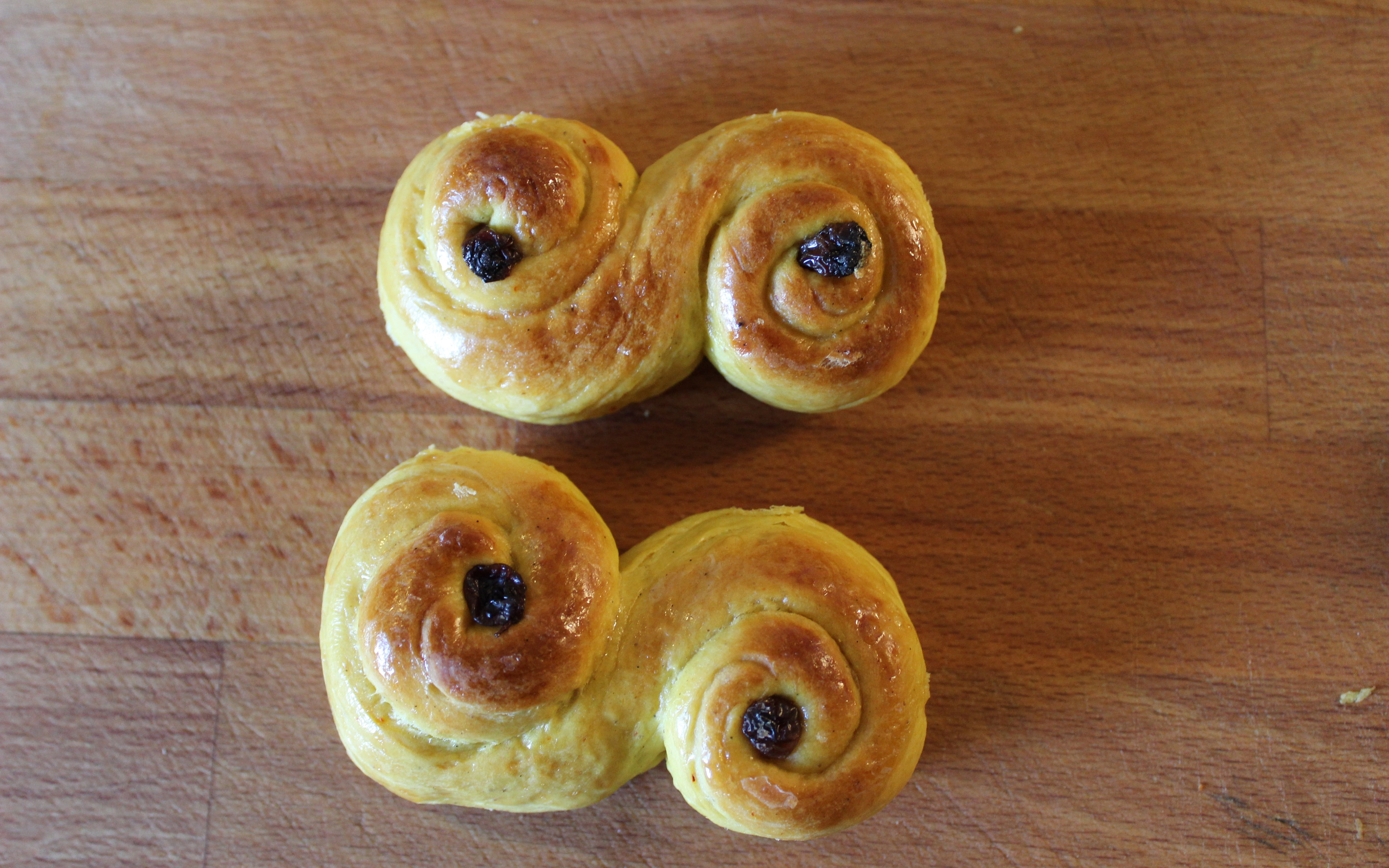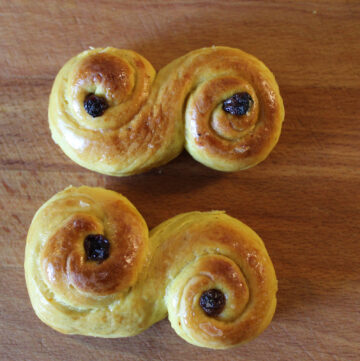
These saffron-infused buns are an integral part of the St. Lucy Day festivities celebrated on December 13 in Sweden. The Festival of Light, as it is often called, marks the beginning of the Christmas season in Scandinavia. The Swedes celebrate this 3rd century Italian martyr during the darkest month of the year because she saved Sweden from a famine in the Middle Ages when she brought wheat on a ship at night surrounded by light. The candle crown is worn because according to legend she brought provisions to the Christians hiding in the catacombs while wearing a candlit wreath on her head to light her way so that she could carry more with her hands.
Traditionally, the eldest girl in the house dresses up in a white robe with a red sash and a candle lit wreath on her head and delivers Lussebullar and coffee to her parents for breakfast.
The slightly sweet yeast buns are flavored with saffron threads steeped in warm milk and then mixed into the rest of the recipe. After rising for a short time, they are shaped and dotted with raisins and baked until golden brown. There are nine different traditional shapes for these saffron buns, but the most popular is the one that is shaped like a backwards S. Watch the video below to find out how to make these nine traditional shapes.

Swedish Saffron Buns / Lussebullar / Lussekatter
Ingredients
- 500 ml whole milk slightly over 2 cups
- 150 g unsalted butter 10.5 tbsp
- 18 g active dry yeast or 50 g fresh yeast 1 tbsp + 1/4 tsp active dry
- 1 egg
- 125 g granulated sugar 2/3 cup
- 1 tsp salt
- 750 g bread flour strong flour (6 1/4 cups)
- handful of raisins
- 1-2 grams of saffron 1 3/4 tsp – 2 3/4 tsp (1 gram is sufficient but 2 grams adds excellent color/flavor)
- 2 tbsp vodka or other neutral spirit
- 1 beaten egg + 1 tbsp water for the egg wash
Instructions
- Combine the saffron and vodka in a small bowl and let sit for several hours, preferably overnight.
- Start by heating the milk and butter in a saucepan on the stove. Heat gently just until the butter is melted. Pour the hot milk into a bowl to cool down. The milk should cool to just above room temperature.
- Strain the saffron out of its liquid. Discard the saffron but keep the liquid. Be careful, saffron stains things very easily. Pour the saffron extract into the cooled milk mixture.
- Stir the yeast into the milk until dissolved. If using active dry yeast, let the mixture sit for 5 minutes until it becomes frothy.
- Pour the milk mixture into your mixer. Add in the sugar, egg, and flour. Using a dough hook, knead on medium speed for 10 minutes, until smooth, shiny, and elastic. The dough should pull away from the sides of the bowl and no longer be sticky. If your dough is still very sticky after mixing for 10 minutes. add flour in one tablespoon at a time until you’ve reached the desired consistency.
- Place the dough into an oiled, covered bowl and let rise for 30-40 minutes, or until doubled in size. The rising time will vary depending on the temperature of your kitchen.
- Once risen, punch down the dough on a lightly floured surface and take a small piece for shaping. Cover the rest of the dough until needed so it doesn’t dry out.
- See the video for shaping instructions. There are nine different traditional shapes. You will be using the raisins during the shaping process.
- Place your shaped buns on a parchment lined baking sheet. Cover and let rise for about 30 minutes, or until puffed up.
- When risen, brush the buns with the egg wash.
- Bake in a 225C/435F preheated oven for 8-15 minutes. The baking time will depend on how small or large the buns are. Try to pair similar sized shapes on your baking sheets for even baking. The buns are ready when they are golden brown and have reached an internal temperature of 88C/190F.

Leave a Reply